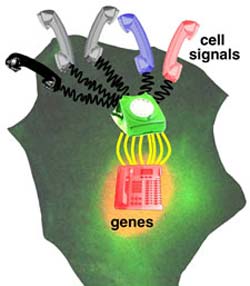Computer Modeling Reveals Hidden Conversations Within Cells

Cells use the timing of signals to communicate, similar to the way a telephone wire carries information about conversations. Credit: Alexander Hoffmann, UCSD
UCSD biochemists have developed a computer program that helps explain a long-standing mystery: how the same proteins can play different roles in a wide range of cellular processes, including those leading to immune responses and cancer.
Prior to the UCSD team’s findings, which are published in the September 16 issue of the journal Science, many scientists expressed doubts that a computational approach could represent the intricate mechanisms through which cells respond to outside signals. However, the researchers report that their computer model accurately predicts particular behaviors of living cells. They also believe that the model has important practical applications, including guiding the design of better treatments for cancer and other diseases that involve failures in cell communication
“Our computational approach revealed how the same set of proteins produce physiologically different outputs in response to only subtly different inputs,” explained Alexander Hoffmann, an assistant professor of chemistry and biochemistry, who led the team. “This is the first step toward developing drugs that interfere with one of the pathological functions of the proteins, but leave the healthy functions intact. For example, many current cancer drugs dramatically reduce immune function. Computer modeling should make it possible to design anti-cancer drugs that do not weaken patients’ immune systems.”
The computer model comprises 70 equations to account for the behavior of five proteins and three RNA molecules in the “NF-kappaB signaling pathway,” which regulates genes involved in cancer, inflammation, immune function and cell death. Each equation takes into account a different parameter, such as how quickly a protein is synthesized, or how quickly it is degraded.
The researchers chose the NF-kappaB proteins because there is a wide body of prior research that they were able to draw on to set the initial parameters in the model. As they were developing the model, they repeatedly tested and refined it by comparing the model’s predictions with the results of experiments with living cells.
“The beauty of this kind of interdisciplinary work is the almost circular way the model’s predictions drive the design of new experiments, and the how results of those experiments can be fed back into the model to improve it,” said Shannon Werner, a graduate student in chemistry and biochemistry, who did the experimental work described in the paper.
Once the model consistently predicted the behavior of living cells in a variety of experimental conditions, the researchers used the model to infer what was going on inside cells in much greater detail than would be possible through laboratory experiments alone.
The model revealed why two natural chemicals have opposite physiological effects. When exposed to one of the chemicals, the proteins create positive feedback that lengthens the amount of time they are active. When exposed to the other chemical, they initiate negative feedback, which shuts them down rapidly.
“The prevailing view has been that proteins are either on or off like a light switch, but that didn’t explain how activating the same proteins with different chemicals could have opposing effects on cells,” explained Hoffmann. “Our model shows that, analogous to how a telephone transmits an infinite number of different signals along a single wire, it is the timing of the proteins’ activity that allows them to exert intricate control over the behavior of a cell. The computer model reveals the hidden conversations in the cell’s wiring.”
The researchers attribute their success in developing the computer model, despite criticism that the computational approach would require too many simplifications to accurately model cell communication, to the diverse expertise they brought together.
“Developing a computer model is both science and art,” said Derren Barken, a graduate student in bioinformatics and experienced software engineer, who programmed the model. “It requires intuition built up over time, but it also requires someone like Alex, who can critically evaluate the scientific literature to decide what parameters need to be included in the model, and someone like Shannon who can take the predictions of the model and design experiments to test them in the laboratory.”
The study was supported by the National Institutes of Health, the National Science Foundation and the UC Academic Senate.
Media Contact: Sherry Seethaler (858) 534-4656
Comment: Alexander Hoffmann (858) 822-4670
Media Contact
More Information:
http://www.ucsd.eduAll latest news from the category: Life Sciences and Chemistry
Articles and reports from the Life Sciences and chemistry area deal with applied and basic research into modern biology, chemistry and human medicine.
Valuable information can be found on a range of life sciences fields including bacteriology, biochemistry, bionics, bioinformatics, biophysics, biotechnology, genetics, geobotany, human biology, marine biology, microbiology, molecular biology, cellular biology, zoology, bioinorganic chemistry, microchemistry and environmental chemistry.
Newest articles

High-energy-density aqueous battery based on halogen multi-electron transfer
Traditional non-aqueous lithium-ion batteries have a high energy density, but their safety is compromised due to the flammable organic electrolytes they utilize. Aqueous batteries use water as the solvent for…

First-ever combined heart pump and pig kidney transplant
…gives new hope to patient with terminal illness. Surgeons at NYU Langone Health performed the first-ever combined mechanical heart pump and gene-edited pig kidney transplant surgery in a 54-year-old woman…

Biophysics: Testing how well biomarkers work
LMU researchers have developed a method to determine how reliably target proteins can be labeled using super-resolution fluorescence microscopy. Modern microscopy techniques make it possible to examine the inner workings…





















